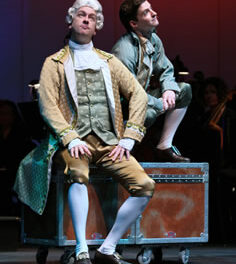The Raleigh Chamber Music Guild’s 2004-5 “Sights & Sounds on Sundays” at the North Carolina Museum of Art ended the season on June 5 with music for flute and percussion – mainly marimba. The artists – flutist Kate Steinbeck and percussionist Byron Hedgepeth, both based in Asheville – have performed together widely in the Carolinas since 1998. They released their first collaborative CD – Light in the Corner – in March 2004. It blends eclectic sounds of America and Asia, evoking the vibrant beauty of primal cultures and World music, and has received critical acclaim. Steinbeck holds degrees in flute performance from Baldwin-Wallace College and the San Francisco Conservatory of Music and has taught in Stuttgart, Germany. Hedgepeth earned degrees from Mars Hill College and the University of Illinois and now teaches at UNC-Asheville.
The concert opened with a piece by the eclectic American composer Alec Wilder. “Flute Piece No 2 with Bongo” had a definite oriental feel about it and, with the bongo played ad libitum by Hedgepeth, it was reminiscent of Bali. “…And the Breath Stirred…” (1992) by Alan Blank, a brief piece for alto flute, had passages reminiscent of the second act love duet from Tristan. It was wistful and a perfect vehicle to demonstrate Steinbeck’s exceptionally beautiful tone.
Clair Omar Musser (1901-98) was a marimba virtuoso and innovator of performance technique. He also was the first to compose extensively for the instrument in a serious or “classical” manner. Hedgepeth performed his solo Prelude, Op. 11, No. 7, on a five-octave marimba. For those who have never been introduced to one, a marimba is an instrument made on an oblong frame, set on legs, with rosewood keys arranged in a configuration similar to piano keys. Below the wooden keys are suspended metal tubes sized to sound the desired tone. The tubes pick up the sound from mallets striking the keys and produce an exceedingly mellow and warm sound. The performer may use one, two, or occasionally even three mallets in each hand. Hedgepeth performed with mastery on this instrument rarely heard in concert presentations.
Steinbeck returned to the stage for a performance of Three Landscapes, a 1988 piece by Tania Gabrielle French. The three movements were titled “Rolling Hills,” “A Winding Path,” and “A Quiet Heath.” It was music evocative of the listeners’ own experience and interpretation of the title of each piece. Next was another suite-like piece by the idiosyncratic New Zealander Gareth Farr. Kembang Suling (1996) was written to capture ambiences reminiscent of Bali, Japan, and India. The middle piece was especially plaintive, with the outer two being just a bit moody and haunting; the suite seemed to accomplish the intent of the composer.
After an intermission, we heard Lou Harrison’s 1987 composition Ariadne. It was introduced by Steinbeck, who reviewed the tragic story of the abandoned goddess. In the first of two sections, “Ariadne Abandoned,” the flute was accompanied by a vibraphone – a marimba-like instrument with an attached electronic device that gives the sound a tremolo effect. The second section, “The Triumph of Ariadne & Dionysos,” was accompanied by a thin cylindrical drum that produced an amazing variety of sounds depending upon where it was struck and the manner in which it was struck by the hand. It was a reminder of the heritage of this unique, visceral, and gifted composer who died just a little over two years ago.
Two Hispanic pieces were next – Dance No. 2, from Mexican Dances for Marimba, by Gordon Stout, and the Argentinean gaucho dance “Casi Una Trunca” by Guillo Espel, which combined fascinating rhythms with intricate harmonies for a delightfully different experience.
Steinbeck and Hedgepeth ended their concert with J.S. Bach’s Sonata in E, S.1035, possibly composed for Michael Gabriel Fredersdorf, chamberlain of Frederick the Great, both of whom were accomplished flutists. Bach on the marimba? Well, yes, why not? Bach was above all a practical and utilitarian man. He used what was available to him always. When he had a fine oboist, he wrote a stunning oboe obbligato for his Sunday cantata. When a fine soprano or bass – or what ever voice – was available, he wrote virtuosic arias. Why not the marimba? The performance was different, but perfectly satisfying. These two artists are accomplished and have developed a program of diverse works that demonstrate their skills well and entertain pleasantly.
The RCMG has announced its programs for the 2005-6 season. There will be six concerts in the Master’s Series, beginning with the Eroica Trio and ending with the Miró Quartet. The Sights and Sounds series also includes six concerts featuring accomplished regional talent such as the Ciompi Quartet with pianist Benjamin Woods. In partnership with Duke and UNC, the Guild also offers the second annual “September Prelude,” this year involving Triple Helix in two off-series concerts plus master classes and workshops. For more details and information on obtaining season tickets (and for chamber music offerings of other area presenters, too), click here (or visit the Guild’s website, at http://www.rcmg.org/) It looks like a smash of a season all the way!











